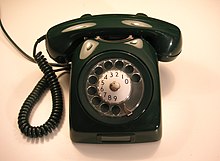Pulse dialing
Pulse dialing ( IWV ) is the name of the oldest signaling method used in automatic telephone exchange .
It used to be the only dialing method and therefore did not need a proper name. Today it has largely been replaced by the multi-frequency dialing procedure (MFV), also called DTMF (dual-tone multi-frequency), for analog telephone connections .
With the invention of the rotary dial ( number switch ) and the associated switching technology, the functionality and protocol of the dialing process was established.
When the telephone receiver is picked up on the analogue terminal, a current loop is closed to the exchange , which supplies the telephone with electricity. This is perceived by the exchange, which in turn feeds the dial tone into the subscriber line and goes to receive. Turning the number switch activates a contact and breaks this loop with it according to the selected digit: When dialing digit 1 once, with digit 2 twice, ... with digit 0 ten times. A single pulse lasts 100 ms. The pulse-pause ratio used in Germany is 60/40, which means that the loop has a pulse duration of 100 ms, is 60 ms open and 40 ms is closed. After the pulse sequence has elapsed, the loop remains closed.
In this way, the dialed digits are converted into voltage pulses that are registered in the exchange. In exchanges using electromagnetic technology (in Germany until around 1980), the step magnets of the rotary selector were activated. So that the user does not hear these impulses, the dial ( number switch ) switches the speech circuit briefly for the duration of the dialing via the NSA contact.
As soon as there is a longer pause, the telephone exchange waits for the next digit. Pressing the hook switch quickly generates pulses which - if the timing is correct - are interpreted by the exchange as dialing pulses. Some coin-operated telephones (e.g. the Tln Mü 55b ) therefore have an additional delay device (mechanical or electrical) in the hook switch to prevent “fork dialing” without paying.
The pause between the selected digits is at least the time of two impulses, i.e. 200 ms. This pause is called inter-digit pause , rarely also called space .
Older telephones with keypad and ringer (multi-frequency dialing) can usually also be converted to pulse dialing. Both dialing methods, key dialing and pulse dialing, are implemented electronically in these convertible telephones.
Since the pulse signaling interrupts the connection to the exchange galvanically and thus also the normal voice channel (which is why the impulses can also be heard in the handset), one speaks of in-band signaling . With ISDN and other digital telephone networks , however, a separate channel is used for signaling (with ISDN the D-channel ). This process is known as out-of-band signaling .
literature
- Lothar Wilhelmy: The new postal keypad for the impulse dialing process , electronics, Franzis-Verlag Munich, 1977, issue 12.
- Hubert Zitt: ISDN & DSL for PC and telephone. Markt + Technik Verlag, Munich 2005, ISBN 3-8272-6987-3 .
- Mareike Bonnekoh: Voice over IP. Legal problems of the convergence of Internet and telephony, LIT Verlag, Berlin 2007, ISBN 978-3-8258-0198-4 .
See also
- Multi-frequency dialing
- The article number switch explains the technical side of the pulse dialing process in great detail.
Web links
- IWV call station circuit
- Telephone with pulse timing circuit diagram with animation
- Process for generating a control signal in a pulse dialing process for a public exchange (accessed on July 6, 2017)
- The telephone, its networks and their influence on everyday private life (accessed on July 6, 2017)
- Adapter for expanding ISDN telephones (accessed July 6, 2017)

